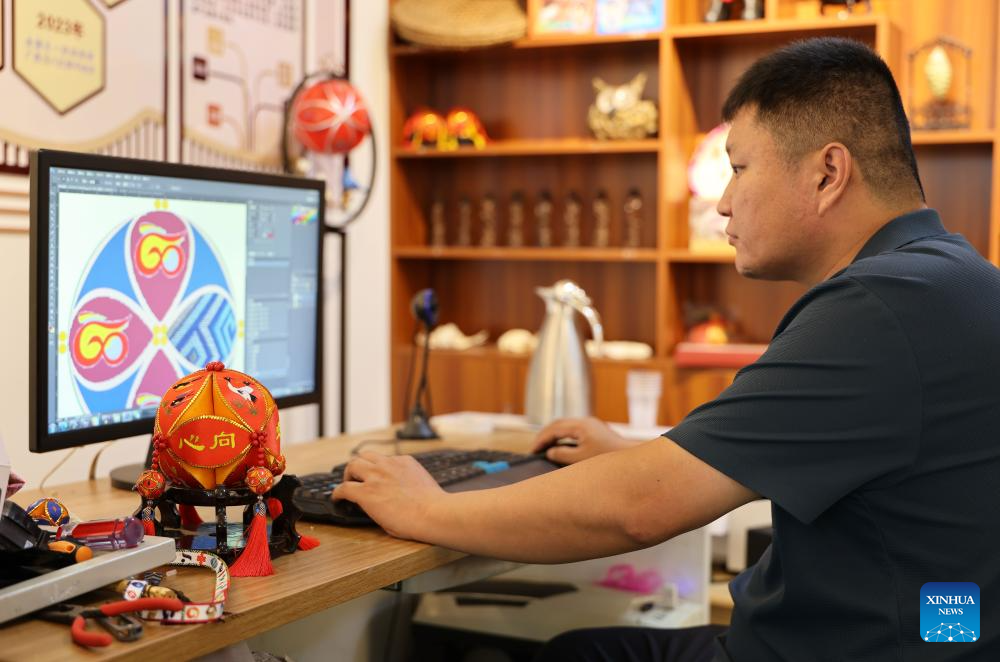


A student throws the embroidered ball at Minzu Road East Primary School in Nanning, south China's Guangxi Zhuang Autonomous Region, Nov 6, 2024. Guangxi Zhuang Autonomous Region is the autonomous region with the largest population of ethnic minorities in China, with multiple ethnic groups such as Zhuang, Yao, Miao, and Dong who have lived there for generations. Throwing embroidered balls is a traditional sport that Guangxi people enjoy, carrying a profound folk heritage. In Zhuang culture, embroidered ball is a symbol of love.
The way of throwing the embroidered ball is very simple, making it suitable for people of all ages. Now it has been turned into a competition involving high poles and baskets, in which everyone can participate as athletes.
Jingxi City, located in the southwest of Guangxi, has a long history of making embroidered balls. In Jiuzhou Village, Jingxi, almost every household can make embroidered balls. At present, the development model of Jingxi embroidered ball has shifted from a traditional small-scale development model to market-oriented and industrialized development model. Nowadays, Jingxi embroidered ball, as a characteristic tourist souvenir, has been sold all over the world. (Xinhua/Jin Haoyuan)

A customer chooses embroidered balls at a canival of the Sanyuesan Festival in Nanning, south China's Guangxi Zhuang Autonomous Region, March 31, 2025. Guangxi Zhuang Autonomous Region is the autonomous region with the largest population of ethnic minorities in China, with multiple ethnic groups such as Zhuang, Yao, Miao, and Dong who have lived there for generations. Throwing embroidered balls is a traditional sport that Guangxi people enjoy, carrying a profound folk heritage. In Zhuang culture, embroidered ball is a symbol of love.
The way of throwing the embroidered ball is very simple, making it suitable for people of all ages. Now it has been turned into a competition involving high poles and baskets, in which everyone can participate as athletes.
Jingxi City, located in the southwest of Guangxi, has a long history of making embroidered balls. In Jiuzhou Village, Jingxi, almost every household can make embroidered balls. At present, the development model of Jingxi embroidered ball has shifted from a traditional small-scale development model to market-oriented and industrialized development model. Nowadays, Jingxi embroidered ball, as a characteristic tourist souvenir, has been sold all over the world. (Xinhua/Cao Yiming)

A student catches a embroidered ball with a basket in Yulin Ethnic Middle School in Yulin, south China's Guangxi Zhuang Autonomous Region, Feb. 19, 2025. Guangxi Zhuang Autonomous Region is the autonomous region with the largest population of ethnic minorities in China, with multiple ethnic groups such as Zhuang, Yao, Miao, and Dong who have lived there for generations. Throwing embroidered balls is a traditional sport that Guangxi people enjoy, carrying a profound folk heritage. In Zhuang culture, embroidered ball is a symbol of love.
The way of throwing the embroidered ball is very simple, making it suitable for people of all ages. Now it has been turned into a competition involving high poles and baskets, in which everyone can participate as athletes.
Jingxi City, located in the southwest of Guangxi, has a long history of making embroidered balls. In Jiuzhou Village, Jingxi, almost every household can make embroidered balls. At present, the development model of Jingxi embroidered ball has shifted from a traditional small-scale development model to market-oriented and industrialized development model. Nowadays, Jingxi embroidered ball, as a characteristic tourist souvenir, has been sold all over the world. (Xinhua/Cao Yiming)

A villager makes an embroidered ball in Jiuzhou Village of Jingxi City, south China's Guangxi Zhuang Autonomous Region, April 2, 2024. Guangxi Zhuang Autonomous Region is the autonomous region with the largest population of ethnic minorities in China, with multiple ethnic groups such as Zhuang, Yao, Miao, and Dong who have lived there for generations. Throwing embroidered balls is a traditional sport that Guangxi people enjoy, carrying a profound folk heritage. In Zhuang culture, embroidered ball is a symbol of love.
The way of throwing the embroidered ball is very simple, making it suitable for people of all ages. Now it has been turned into a competition involving high poles and baskets, in which everyone can participate as athletes.
Jingxi City, located in the southwest of Guangxi, has a long history of making embroidered balls. In Jiuzhou Village, Jingxi, almost every household can make embroidered balls. At present, the development model of Jingxi embroidered ball has shifted from a traditional small-scale development model to market-oriented and industrialized development model. Nowadays, Jingxi embroidered ball, as a characteristic tourist souvenir, has been sold all over the world. (Xinhua/Cao Yiming)

Artists performs with embroidered balls in Hechi, south China's Guangxi Zhuang Autonomous Region, Jan. 24, 2025. Guangxi Zhuang Autonomous Region is the autonomous region with the largest population of ethnic minorities in China, with multiple ethnic groups such as Zhuang, Yao, Miao, and Dong who have lived there for generations. Throwing embroidered balls is a traditional sport that Guangxi people enjoy, carrying a profound folk heritage. In Zhuang culture, embroidered ball is a symbol of love.
The way of throwing the embroidered ball is very simple, making it suitable for people of all ages. Now it has been turned into a competition involving high poles and baskets, in which everyone can participate as athletes.
Jingxi City, located in the southwest of Guangxi, has a long history of making embroidered balls. In Jiuzhou Village, Jingxi, almost every household can make embroidered balls. At present, the development model of Jingxi embroidered ball has shifted from a traditional small-scale development model to market-oriented and industrialized development model. Nowadays, Jingxi embroidered ball, as a characteristic tourist souvenir, has been sold all over the world. (Xinhua/Cao Yiming)

A Dutch cyclist kisses a embroidered ball after the 3rd stage of Tour of Guangxi/UCI World Tour from Jingxi to Bama, south China's Guangxi Zhuang Autonomous Region, Oct. 17, 2024. Guangxi Zhuang Autonomous Region is the autonomous region with the largest population of ethnic minorities in China, with multiple ethnic groups such as Zhuang, Yao, Miao, and Dong who have lived there for generations. Throwing embroidered balls is a traditional sport that Guangxi people enjoy, carrying a profound folk heritage. In Zhuang culture, embroidered ball is a symbol of love.
The way of throwing the embroidered ball is very simple, making it suitable for people of all ages. Now it has been turned into a competition involving high poles and baskets, in which everyone can participate as athletes.
Jingxi City, located in the southwest of Guangxi, has a long history of making embroidered balls. In Jiuzhou Village, Jingxi, almost every household can make embroidered balls. At present, the development model of Jingxi embroidered ball has shifted from a traditional small-scale development model to market-oriented and industrialized development model. Nowadays, Jingxi embroidered ball, as a characteristic tourist souvenir, has been sold all over the world. (Xinhua/Cao Yiming)

A villager makes an embroidered ball in Jiuzhou Village of Jingxi City, south China's Guangxi Zhuang Autonomous Region, April 2, 2024. Guangxi Zhuang Autonomous Region is the autonomous region with the largest population of ethnic minorities in China, with multiple ethnic groups such as Zhuang, Yao, Miao, and Dong who have lived there for generations. Throwing embroidered balls is a traditional sport that Guangxi people enjoy, carrying a profound folk heritage. In Zhuang culture, embroidered ball is a symbol of love.
The way of throwing the embroidered ball is very simple, making it suitable for people of all ages. Now it has been turned into a competition involving high poles and baskets, in which everyone can participate as athletes.
Jingxi City, located in the southwest of Guangxi, has a long history of making embroidered balls. In Jiuzhou Village, Jingxi, almost every household can make embroidered balls. At present, the development model of Jingxi embroidered ball has shifted from a traditional small-scale development model to market-oriented and industrialized development model. Nowadays, Jingxi embroidered ball, as a characteristic tourist souvenir, has been sold all over the world. (Xinhua/Cao Yiming)

Wang Xiufen, the chief craftsperson of an embroidered ball production company, adjusts the divice at the company in Jingxi, south China's Guangxi Zhuang Autonomous Region, April 3, 2024. Guangxi Zhuang Autonomous Region is the autonomous region with the largest population of ethnic minorities in China, with multiple ethnic groups such as Zhuang, Yao, Miao, and Dong who have lived there for generations. Throwing embroidered balls is a traditional sport that Guangxi people enjoy, carrying a profound folk heritage. In Zhuang culture, embroidered ball is a symbol of love.
The way of throwing the embroidered ball is very simple, making it suitable for people of all ages. Now it has been turned into a competition involving high poles and baskets, in which everyone can participate as athletes.
Jingxi City, located in the southwest of Guangxi, has a long history of making embroidered balls. In Jiuzhou Village, Jingxi, almost every household can make embroidered balls. At present, the development model of Jingxi embroidered ball has shifted from a traditional small-scale development model to market-oriented and industrialized development model. Nowadays, Jingxi embroidered ball, as a characteristic tourist souvenir, has been sold all over the world. (Xinhua/Cao Yiming)

Liu Changlei, the general manager of an embroidered ball production company, designs embroidered balls in his office in Jingxi, south China's Guangxi Zhuang Autonomous Region, Oct. 17, 2024. Guangxi Zhuang Autonomous Region is the autonomous region with the largest population of ethnic minorities in China, with multiple ethnic groups such as Zhuang, Yao, Miao, and Dong who have lived there for generations. Throwing embroidered balls is a traditional sport that Guangxi people enjoy, carrying a profound folk heritage. In Zhuang culture, embroidered ball is a symbol of love.
The way of throwing the embroidered ball is very simple, making it suitable for people of all ages. Now it has been turned into a competition involving high poles and baskets, in which everyone can participate as athletes.
Jingxi City, located in the southwest of Guangxi, has a long history of making embroidered balls. In Jiuzhou Village, Jingxi, almost every household can make embroidered balls. At present, the development model of Jingxi embroidered ball has shifted from a traditional small-scale development model to market-oriented and industrialized development model. Nowadays, Jingxi embroidered ball, as a characteristic tourist souvenir, has been sold all over the world. (Xinhua/Jin Haoyuan)

Embroidered balls are seen in Hechi University in Hechi, south China's Guangxi Zhuang Autonomous Region, March 26, 2025. Guangxi Zhuang Autonomous Region is the autonomous region with the largest population of ethnic minorities in China, with multiple ethnic groups such as Zhuang, Yao, Miao, and Dong who have lived there for generations. Throwing embroidered balls is a traditional sport that Guangxi people enjoy, carrying a profound folk heritage. In Zhuang culture, embroidered ball is a symbol of love.
The way of throwing the embroidered ball is very simple, making it suitable for people of all ages. Now it has been turned into a competition involving high poles and baskets, in which everyone can participate as athletes.
Jingxi City, located in the southwest of Guangxi, has a long history of making embroidered balls. In Jiuzhou Village, Jingxi, almost every household can make embroidered balls. At present, the development model of Jingxi embroidered ball has shifted from a traditional small-scale development model to market-oriented and industrialized development model. Nowadays, Jingxi embroidered ball, as a characteristic tourist souvenir, has been sold all over the world. (Xinhua/Cao Yiming)
点击右上角![]() 微信好友
微信好友
 朋友圈
朋友圈

请使用浏览器分享功能进行分享
